Description of varieties and features of growing terry petunia
Petunia is one of the most popular landscaping plants. It is appreciated for its unpretentiousness, undemanding care, ease of reproduction, duration of flowering. Low-growing bushes delight with abundant flowering from mid-spring to the very frost. If desired, the flower can be saved for next year by placing it in an apartment for the winter.
The most beautiful variety of this plant is terry petunia. It is distinguished by large inflorescences with a large number of petals arranged in several rows. Flowers come in many shades, some with unusual patterns. About what varieties of this variety of petunias exist and how to grow them, we will tell further.
The content of the article
Description of terry petunia
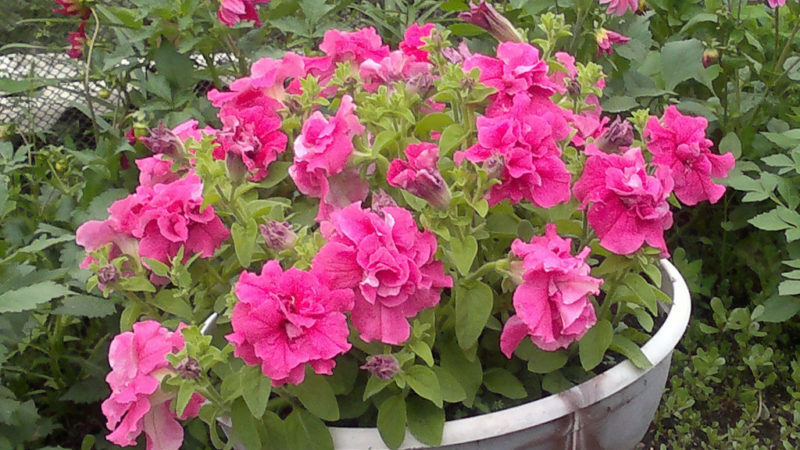
Terry petunia is one of the most beautiful low-growing flowering plants. Its main advantage over other varieties of this culture is in large unusual inflorescences.
Thin and delicate petals of terry petunia have cuts and corrugated areas. They are located on the receptacle in several layers. Because of this, the buds look voluminous.
Most varieties terry petunias large flowers. Some of them are over 10 cm in diameter.
The color of the inflorescence is different. There are pink, dark purple, white, yellow, crimson, purple, lilac specimens. Varieties with inflorescences are popular, the color of the petals of which along the edge differs from the shade in the center.
Inflorescences in abundance are formed on bushes, the height of which reaches 15-30 cm. The leaves are oval-rounded, bright green, with pointed tips on both sides.
Petunia blooms from late spring until the first frost. Despite the fact that it is considered a perennial, in our country it is often grown as an annual plant.
Note! To prolong the life of the petunia, it is brought into the house for the winter. In the spring, a lot of cuttings.
Terry petunia is unpretentious in care, but has features of cultivation.
Popular varieties and hybrids of terry petunias
There are many varieties and hybrids of terry petunias, with more every year. They differ in the duration of flowering, the shade and size of the inflorescences, resistance to diseases, the height of the bush.
Note! "Seeds of Altai", "Golden Hectar" and "Gavrish" are the most famous brands that produce petunia seeds.
Large-flowered Valentine F1
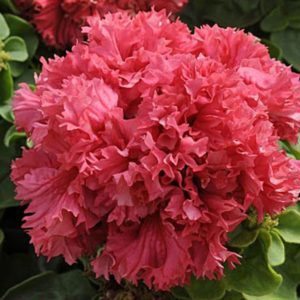
Terry petunia Valentine is one of the most beautiful hybrids. It forms flowers early, retains a bright shade for a long time and is resistant to negative environmental factors.
The size of each flower is from 7 to 10 cm. The flowers are voluminous, spherical, strongly corrugated, with pronounced cuts on bright red petals.
Petunia Valentina reaches a height of 30-40 cm. The bush is branched, wide.
Burgundy

Petunia Burgundy is a hybrid that is resistant to cold snaps, wet and windy weather, precipitation. Rarely sick and affected by insects. It is considered ideal for beginners.
The flowers are large, with many double petals located close to each other. Because of this, inflorescences up to 10 cm in diameter look lush.
The flowers have a deep burgundy color known as burgundy.They are formed on the bush in such an amount that they almost completely cover all the leaves. Flowering lasts from May to early October.
White Sonata
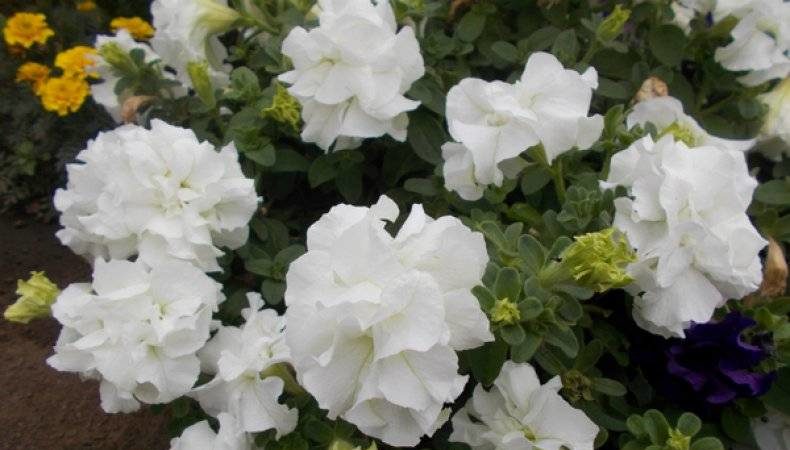
White terry petunia Sonata (another hybrid, not a variety, as it is often called) will not leave indifferent any grower. Its main feature is its ultra-early flowering. The first inflorescences appear on the bushes in April, which is a month earlier than other varieties.
Large densely double inflorescences reach a diameter of 12 cm. They have many corrugated and cut petals arranged in layers one above the other.
White color, without extraneous inclusions. The bush is densely covered with flowers.
The maximum height of the Sonata is 35 cm. It is not afraid of cold snaps and adverse weather conditions.
Double Cascade Blue
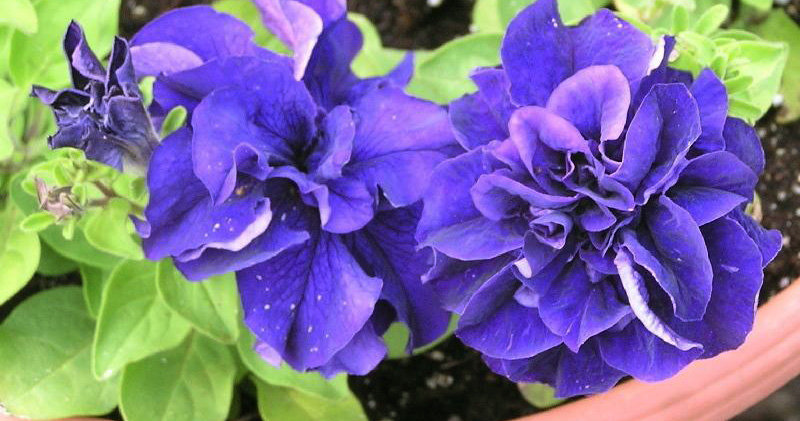
Terry petunia Double Cascade Blue strikes with its unusual color. This is one of the most interesting hybrids.
Double Cascade Blue is a large-flowered hybrid. The diameter of each inflorescence varies between 10-13 cm. The petals are wavy, with cuts. The flowers are spherical, large.
The color of the petals is dark purple. The inner side is covered with villi, which is why it acquires a bluish tint.
Despite the large-flowered nature, the bush is miniature, the height varies between 12-15 cm.
Pirouette
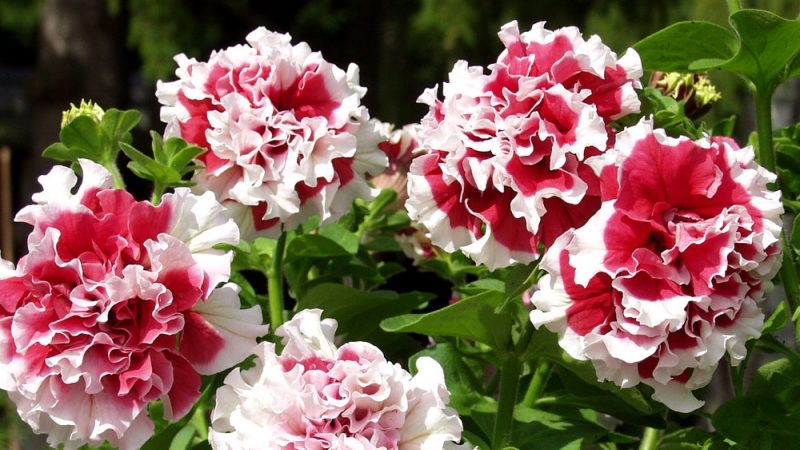
The pirouette is often used in landscape design. Large, lush flowers with highly corrugated petals reach a size of 15 cm and resemble balls. On the bush, they are formed in large quantities.
The color of the Pirouette petals can be different, most have a white border at the edges. On the bush, specimens of white or pink are sometimes formed with small blotches of the second shade, but such cases are rare.
Bushes are undersized. Their maximum height is 15 cm.
The most interesting option from this series is considered to be the Pirouette Parple petunia - purple flowers with a white border around the edges.
Duo
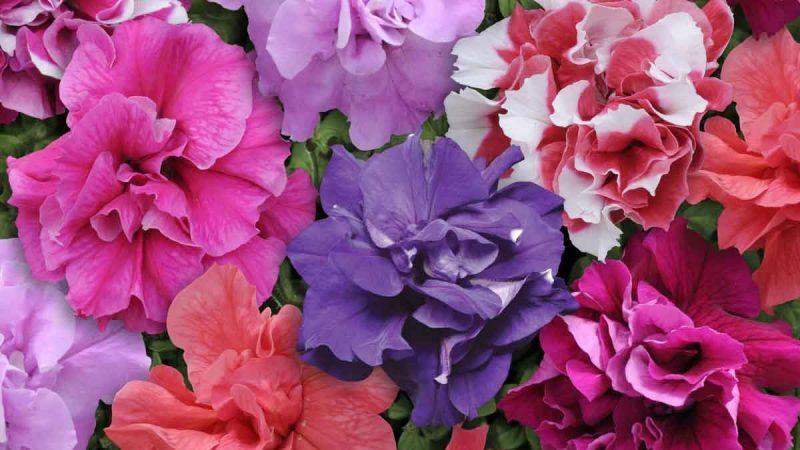
Petunia Duo looks simpler than the previous options. It is distinguished by its unpretentiousness and compactness. Popular with novice gardeners.
The flowers are medium in size, each up to 6 cm in diameter. The shade of the petals is different. There are red, purple, pink, purple, crimson flowers of the Duo variety.
For terry varieties, the bushes are tall - they reach 35 cm.
Note! There are several Duo hybrids: Duo Rose & White, Duo Red & White, Duo Marzipan, Duo Salmon, Duo Lavender. They differ in shades.
Multi-flowered Tart Bonanza

Bonanza tart is a multi-flowered petunia with an unusual color of inflorescences. This is the brightest variety described.
Differs in multi-colored inflorescences. There are flowers of purple, blue, pink, lilac and red shades. Some have white stripes on their petals.
The size of the buds varies within 5-7 cm. The petals are corrugated, without cuts.
Features of growing terry petunias
This beautiful plant is unpretentious, so even a beginner can cope with its cultivation.
Advice! The short stature of terry petunia allows it to be used as a frame for a flower garden.
Growing seedlings and seedlings
Petunia is propagated by vegetative and generative methods. In the first case, cuttings are used, in the second, seeds.
Seeds
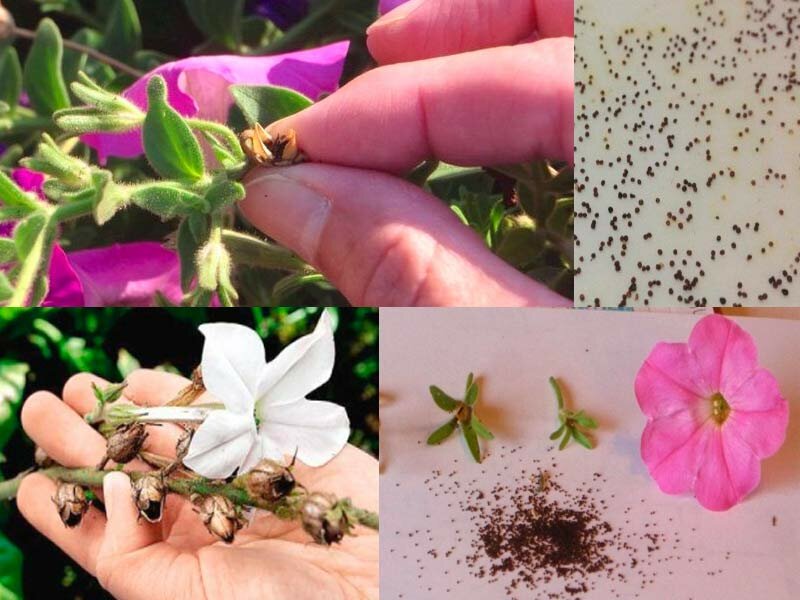
Not all petunias can be propagated by seeds. Some do not form seeds, they are propagated vegetatively. Even if the plant forms planting material, it is not recommended to use self-collected seeds, since they rarely retain maternal characteristics.
The seeds are bought in specialized stores. They are granular and loose. The former are more convenient to sow, while the latter are cheaper and more in the package.
There is no need to disinfect and stimulate the seeds - they are prepared by the manufacturer. If there is no information on processing on the package, the seeds are soaked for half an hour in a light pink solution of potassium permanganate.
The seeds are sown in a container filled with drainage and soil.Petunia is not buried, but slightly pressed into the ground... The soil is moistened from a spray bottle with a growth stimulator. Then the container with the crops is covered with a foil and removed to a warm place until germination.
The soil is moistened as it dries from a spray bottle until the seeds germinate and under the root from a watering can with a narrow neck. The film is opened daily for airing, and after the emergence of shoots, they are removed. Before this, the seedlings are hardened, gradually increasing the duration of airing.
In separate containers, the seedlings are dived after the appearance of two true leaves. It is convenient to transplant seedlings into transparent plastic cups. The second transplant is carried out when the root system fills the entire container.
Cuttings

The easiest way to propagate petunia is a vegetative way. Seedlings are bought in markets and nurseries or cut independently from a bush brought into the house for the winter.
For self-propagation of plants from the bush, cut off all shoots up to 10 cm long. They must be healthy and have at least 2 nodes. All leaves, except for the top two, are removed from the blanks.
The cuttings are planted in moist, loose soil or sand so that they stand unsupported. It is convenient to use one large common container for rooting. Cover the top with a film.
Note! Terry petunia does not take root well in water.
The seedlings are ventilated daily. Water at the root as the soil dries.
When the cuttings take root (after 1-2 weeks), the seedlings are transplanted into individual containers. The root collar is not buried.
Priming
Soil for generative and vegetative way growing petunias use the same. Buy a universal flower potting soil or seedling soil.
To prepare the soil on your own, mix garden soil, humus and sand in equal proportions. Add 1 tbsp to a bucket of soil. ash.
Both purchased and homemade soil are disinfected: watered with a dark pink solution of potassium permanganate or copper sulfate.
Landing in open ground
In open ground the plant is planted in late April or March, depending on the temperature outside. A week before planting in a permanent place, the plants are hardened by taking them outside and gradually increasing the time they stay there.
Before planting, the flower bed is prepared: it is dug up and cleaned of weeds. 5 kg of rotted manure, 30 g of superphosphate and 25 g of potassium salt are applied per 1 m².
Petunias are planted at a distance of at least 30 cm from each other. The root collar is not buried. After planting, the bushes are watered with warm water under the root.
Important! In order for petunia to develop correctly, it is formed at the stage of growing seedlings. To do this, pinch the growing point on the main stem after the formation of the third pair of leaves. This stimulates the appearance of lateral shoots.
Care
When growing, they are guided by the basic rules for caring for petunia.
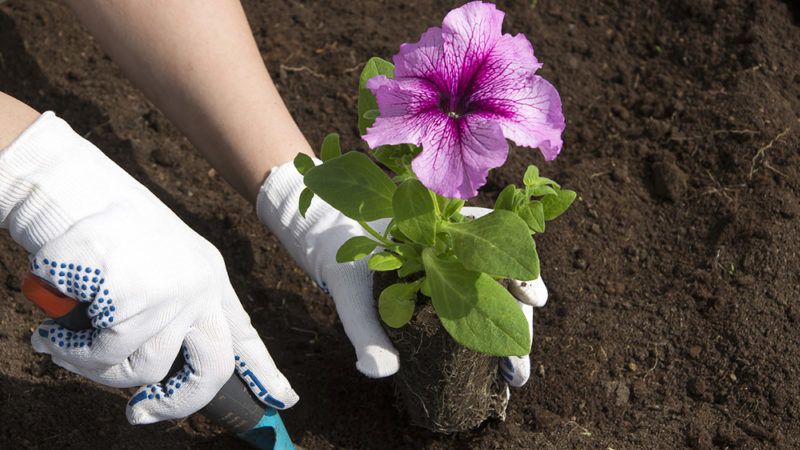
Watering
The soil is moistened as it dries. This is usually done once every 2-3 days. In hot summers, plants are watered more often. Settled warm water is used.
Loosening
After each watering, the soil is loosened, destroying the earthen crust. Without this, the roots of the plant will begin to rot and hurt. In the process of loosening, weeds are removed.
Mulching
Mulch slows down the growth of weeds, protects the roots from cold weather, diseases and pests, allows you to reduce the frequency of loosening. The soil around the petunias is covered with humus, rotted straw, sawdust, pieces of bark, etc.
Top dressing
During flowering, plants are fed every 14 days. Use special purchased drugs or homemade products.
Usually, mineral dressing is prepared from a bucket of water, 25 g of potassium salt, 35 g of superphosphate and 2 tbsp. l. urea. The most popular organic fertilizer is chicken manure diluted with water in a 1:10 ratio.
Removal of peduncles
To ensure the most abundant flowering of petunias, the buds are removed after wilting.If you leave the flower stalks, fruits with seeds are formed from them. Because of this, the number of inflorescences on the bush will decrease.
Prevention of diseases and pests
Sometimes petunia is affected by diseases and pests. To prevent infection, it is important to follow the rules of prevention:
- weed the flower garden regularly;
- loosen the soil after watering;
- disinfect the soil, containers and planting material;
- carry out spring spraying with a solution of copper sulfate;
- do not use ice water for irrigation.
Conclusion
Terry petunia is the most beautiful variety of this plant. It has beautiful, lush, large and bright flowers and blooms profusely all summer. With proper wintering, it can be preserved for the next year.
Growing terry petunias is no more difficult than cultivating other varieties of this plant. Such flowers are distinguished by their unpretentious care and resistance to negative environmental factors.